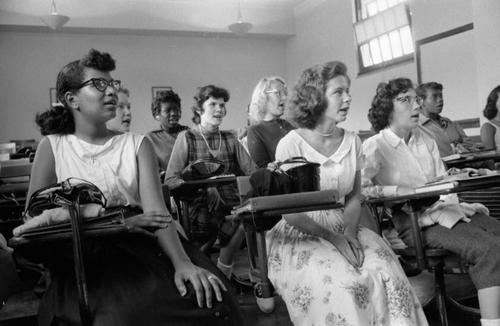Niall Ferguson: How Ike’s 1950s America Beat The ‘Asian Flu’ With Science & Common Sense
This essay is adapted from Mr. Ferguson’s new book, “Doom: The Politics of Catastrophe,” which will be published by Penguin Press on May 4. He is a senior fellow at the Hoover Institution at Stanford University.
In 1957, the U.S. rose to the challenge of the ‘Asian flu’ with stoicism and a high tolerance for risk, offering a stark contrast with today’s approach to Covid-19…
“Bliss was it in that dawn to be alive,/But to be young was very heaven!” Wordsworth was talking about France in 1789, but the line applies better to the America of 1957. That summer, Elvis Presley topped the charts with “(Let Me Be Your) Teddy Bear.” But we tend to forget that 1957 also saw the outbreak of one of the biggest pandemics of the modern era. Not coincidentally, another hit of that year was “Rockin’ Pneumonia and the Boogie Woogie Flu” by Huey “Piano” Smith & the Clowns.
When seeking historical analogies for Covid-19, commentators have referred more often to the catastrophic 1918-19 “Spanish influenza” than to the flu pandemic of 1957-58. Yet the later episode deserves to be much better known, not just because the public health threat was a closer match to our own but because American society at the time was better prepared—culturally, institutionally and politically—to deal with it.
The “Asian flu”—as it was then uncontroversial to call a contagious disease that originated in Asia—was a novel strain (H2N2) of influenza A. It was first reported in Hong Kong in April 1957, having originated in mainland China two months before, and—like Covid-19—it swiftly went global.
Like Covid-19, the Asian flu led to significant excess mortality. The most recent research concludes that between 700,000 and 1.5 million people worldwide died in the pandemic. A pre-Covid study of the 1957-58 pandemic concluded that if “a virus of similar severity” were to strike in our time, around 2.7 million deaths might be anticipated worldwide. The current Covid-19 death toll is 3 million, about the same percentage of world population as were killed in 1957–58 (0.04%, compared with 1.7% in 1918-19).
True, excess mortality in the U.S.—now around 550,000—has been significantly higher in relative terms in 2020-21 than in 1957-58 (at most 116,000). Unlike Covid-19, however, the Asian flu killed appreciable numbers of young people. In terms of excess mortality relative to baseline expected mortality rates, the age groups that suffered the heaviest losses globally were 15- to 24-year-olds (34% above average mortality rates) followed by 5- to 14-year-olds (27% above average). In total years of life lost in the U.S., adjusted for population, Covid has been roughly 40% worse than the Asian flu.
The Asian flu and Covid-19 are very different diseases, in other words. The Asian flu’s basic reproduction number—the average number of people that one person was likely to infect in a population without any immunity—was around 1.65. For Covid-19, it is likely higher, perhaps 2.5 or 3.0. Superspreader events probably played a bigger role in 2020 than in 1957: Covid has a lower dispersion factor—that is, a minority of carriers do most of the transmission. On the other hand, people had more reason to be afraid of a new strain of influenza in 1957 than of a novel coronavirus in 2020. The disastrous pandemic of 1918 was still within living memory, whereas neither SARS nor MERS had produced pandemics.
High school students in Washington, D.C., September 1957. PHOTO: EVERETT COLLECTION
The first cases of Asian flu in the U.S. occurred early in June 1957, among the crews of ships berthed at Newport, R.I. Cases also appeared among the 53,000 boys attending the Boy Scout Jamboree at Valley Forge, Penn. As Scout troops traveled around the country in July and August, they spread the flu. In July there was a massive outbreak in Tangipahoa Parish, La. By the end of the summer, cases had also appeared in California, Ohio, Kentucky and Utah.
It was the start of the school year that made the Asian flu an epidemic. The Communicable Disease Center, as the CDC was then called, estimated that approximately 45 million people—about 25% of the population—became infected with the new virus in October and November 1957. Younger people experienced the highest infection rates, from school-age children up to adults age 35-40. Adults over 65 accounted for 60% of influenza deaths, an abnormally low share.
Why were young Americans disproportionately vulnerable to the Asian flu? Part of the explanation is that they had not been as exposed as older Americans to earlier strains of influenza. But the scale and incidence of any contagion are functions of both the properties of the pathogen itself and the structure of the social network that it attacks. The year 1957 was in many ways the dawn of the American teenager. The first baby boomers born after the end of World War II turned 13 the following year. Summer camps, school buses and unprecedented social mingling after school ensured that between September 1957 and March 1958 the proportion of teenagers infected with the virus rose from 5% to 75%.
The policy response of President Dwight Eisenhower could hardly have been more different from the response of 2020.
*****
Continue reading this article at Zero Hedge.





